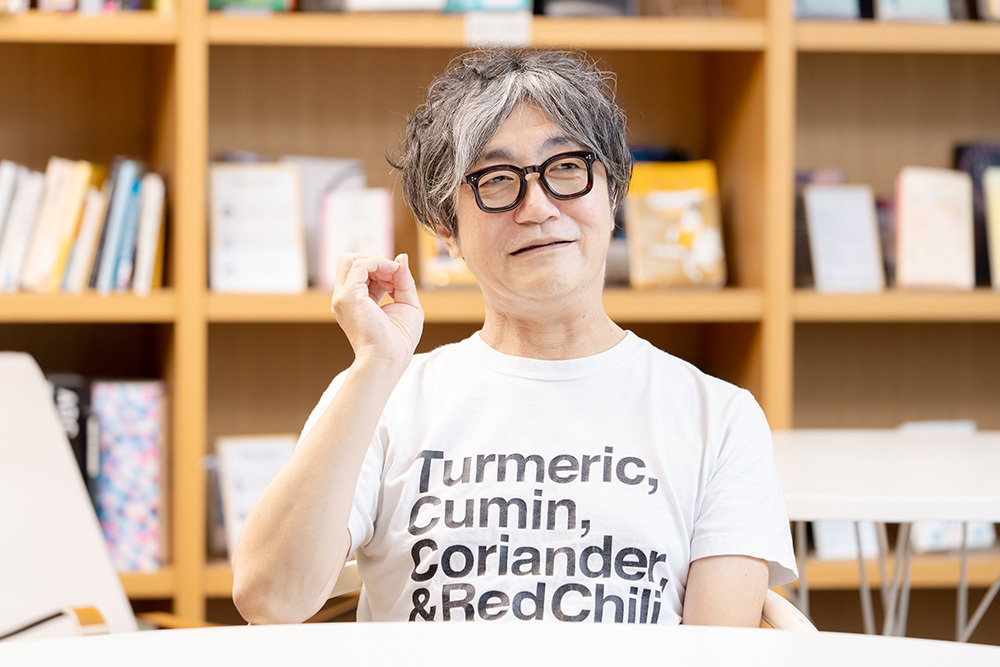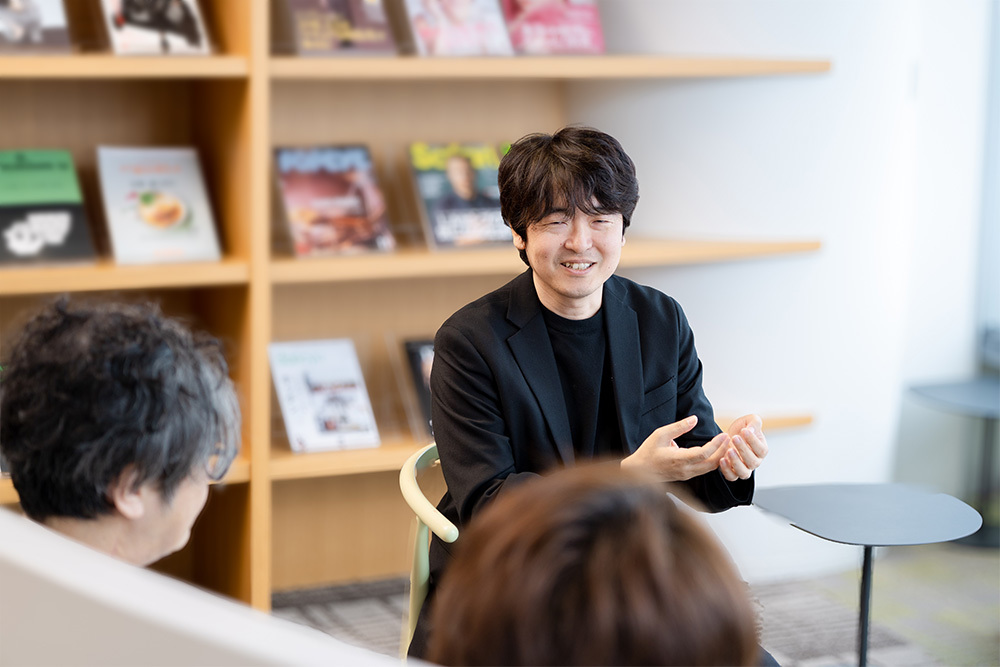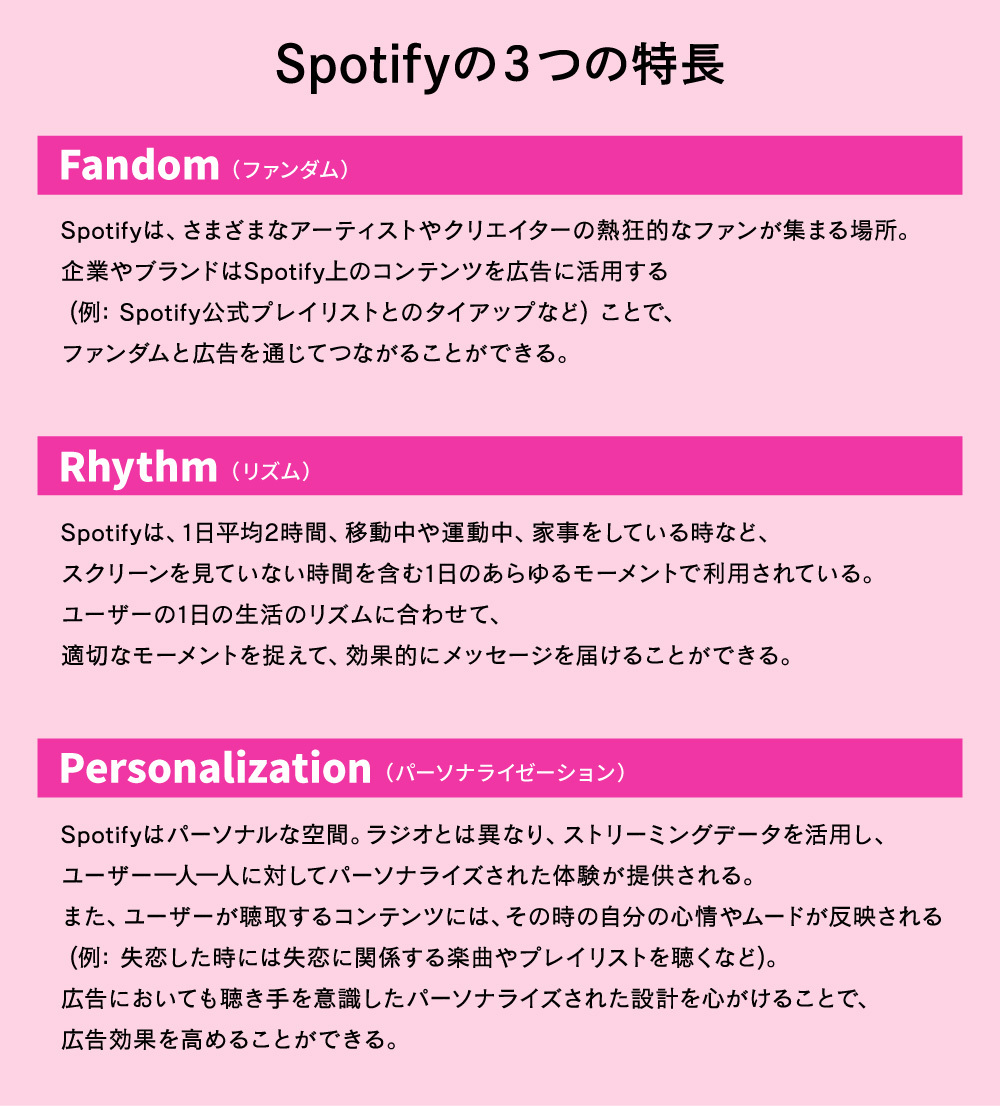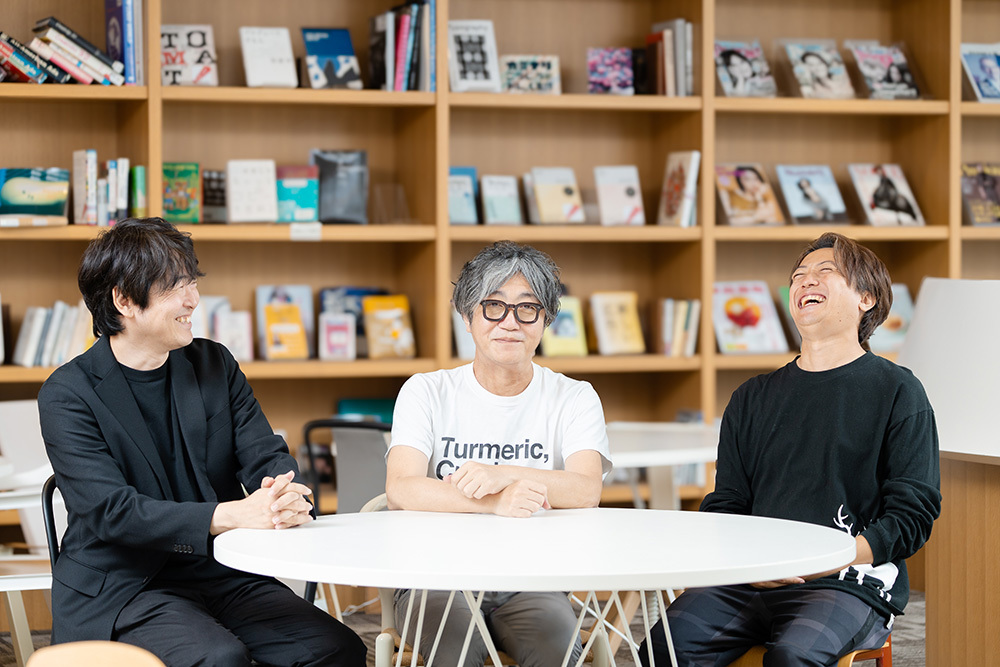Spotify, the world's largest audio streaming service, held its first-ever "Spotify Hits" advertising creative award in Japan (see overview here ). This article introduces the winning entries while exploring the characteristics of successful creative and advertising on Spotify, its marketing value, and the potential of audio advertising.
We welcomed Koichiro Shima (Executive Officer, Hakuhodo), who served as a judge for "Hits," and Takuma Kawada (Creative Director, Dentsu Inc. CXCC), who worked on the winning entries, as guests. Shin Namikawa (Center Director, Dentsu Inc. CXCC), an expert in audio advertising, conducted the interview.
Spotify Hits
An award recognizing campaigns by companies and brands that moved people's hearts and contributed to business growth through creative approaches leveraging the unique characteristics of Spotify advertising. In addition to the Grand Prix (Spotify Mic Drop), two category awards were presented: Best Audio Campaign (Future Sounds) and Best Multi-Format Campaign (Sound & Story).
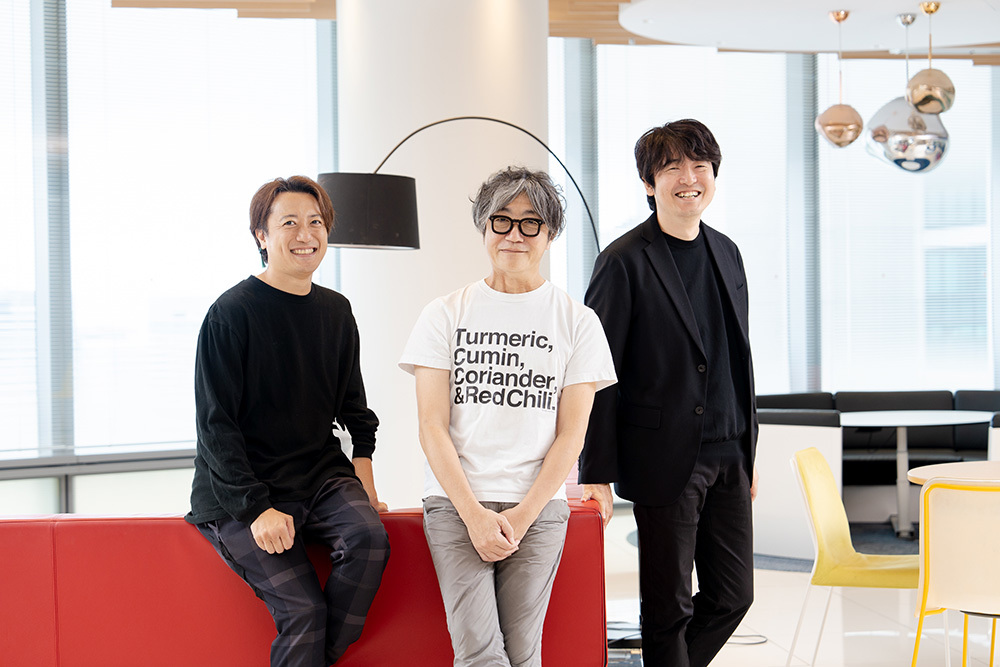
From left: Takuma Kawada (Creative Director/Copywriter, Dentsu Inc. CXCC), Koichiro Shima (Executive Officer, Hakuhodo / Director & Creative Director, Hakuhodo Kettle / Editor), Susumu Namikawa (Center Director, Executive Creative Director, Dentsu Inc. CXCC)
Not Just Audio Ads! Award-Winning Work Exploring Spotify Advertising's Potential

Namikawa: "Spotify Hits" is an advertising award hosted by Spotify that began in Brazil and Mexico in 2023. In 2024, it will be held in countries around the world, including Japan and the United States. Mr. Shima, as a judge, could you share your overall impressions of the submitted entries?
Shima: We saw diverse approaches from various industries like food & beverage, daily necessities, IT, finance, automotive, and mass media. Approximately 80% of Spotify users listen with headphones, immersing themselves in their favorite music and content. Companies deliver their ads into this space where each person is immersed in their own world. The question is: what kind of connection can you create there? Reviewing the entries, I felt there was a unique way for companies to engage with users on Spotify, distinct from radio advertising.
Namikawa: The Grand Prix winner was the advertisement for KFC Japan's "Japanese-Style Chicken Katsu Burger" (commonly known as the "Wakatsu Burger").
You can listen to the ad here
Shima: This ad is a parody of the Takasu Clinic CM song. Starting with the closing line "Let's go eat Wagatsu," which rhymes "Takasu → Wagatsu" and "Clinic → go eat," it's meticulously crafted to mirror the original ad, including sound effects and the music used. It's really funny how you listen thinking, "Huh? Is this a Takasu Clinic ad?" only to have KFC's name appear at the end, revealing it was actually an ad for their Wagatsu Burger.
Namikawa: It's a unique concept, basing the production on an advertisement everyone knows.
Shima: What's particularly noteworthy about this ad is how much emphasis it places on the auditory experience. The approach of creating while thinking, "This sound should be heard like this," is a production process unique to Spotify. While they obtained permission from Takasu Clinic to make it, you could also feel the respect for the original ad.
Namikawa: The "Best Audio Campaign" award, given to ads that excel in sound, went to Earth Pharmaceutical's "Earth No-Mat" ad. This ad introduces the product's features through a mix of three-dimensional mosquito wing sounds and phrases from comedian Kojima Yoshio's signature routines, like "That's irrelevant!" and "It's okay, it's okay." What did you both think?
You can listen to the ad here
Kawada: I thought it was particularly interesting among the entries. Since many people listen to Spotify with headphones, effectively incorporating "spatial audio" has become a key element in ad production. The Earth No-Mat ad uses spatial audio for the mosquito's wing sounds, creating a vivid sense of the mosquito flying from right to left. As a creator, I thought "They got me!" – both for focusing on the mosquito's wing sounds and for achieving that perfect balance where the sound is clearly audible yet not irritating.
Namikawa: Listening to this ad, it even feels "stylish." It reminded me of a DJ sampling and remixing various sounds.
Shima: The sound design, starting with the buzzing, is incredible. From grabbing attention to tying it back to the product, it compactly weaves various elements into one track, showing us a new world different from traditional CM songs.
Namikawa: The "Best Multi-Format Campaign" award, given to ads that achieved results by utilizing multiple Spotify ads, was won by the "Driell" ad for SS Pharmaceutical, handled by Mr. Kawada.
You can listen to the ad here
Kawada: Spotify allows you to create landing pages with interactive features by leveraging streaming data and playlists through API integration. On September 3rd, "Sleep Day," we launched the special "World Lullaby Museum" page in collaboration with Spotify, introducing 100 lullabies from around the world. Furthermore, listeners can select playlists based on their "current mood." To drive traffic to the "World Lullaby Museum," we also created Spotify audio ads and static image ads.
Namikawa: Please tell us about the background of this production.
Kawada: As the sleep aid "Driell" approached its 20th anniversary, the client requested "an advertising approach different from before to enhance brand favorability." While brainstorming concepts, we focused on the fact that "diverse lullabies exist around the world." We felt that Driell's philosophy of "wishing for everyone's peaceful sleep" aligns perfectly with the message conveyed in lullabies from around the world: "May you sleep well." This led us to create the "Driell × Lullabies" campaign.
Namikawa: Creating content where people can listen to lullabies from around the world to elevate the brand image is something only Spotify could do. As a judge, what aspects did you value, Mr. Shima?
Shima: Drielle's project utilizing playlists transcended the boundaries of advertising, elevating itself into a standalone entertainment content service. I felt this was highly effective branding. While playlists are one of Spotify's key features, they are essentially "curated collections." Even with the same songs, different curation can convey entirely distinct worlds.
Namikawa: This demonstrates that Spotify advertising isn't limited to audio, video, or display. I sensed new possibilities for letting users experience a brand's worldview in a multidimensional way.
What are the three key features of Spotify to keep in mind for ad creation?
Namikawa: When creating Spotify ads, it's recommended to incorporate the platform's three core features: "Fandom," "Rhythm," and "Personalization."
Namikawa: First, regarding "Fandom," it's crucial to understand Spotify as a place where passionate fans of artists and creators gather, and then consider how companies can effectively communicate within that space.
Shima: Among the entries this time, one that clearly understood "Fandom" was the audio ad for "Asahi Draft Beer" (commonly known as Marufu). This ad features an artist selected for "RADAR: Early Noise," a program supporting next-generation artists spotlighted by Spotify. The artist reflects on their year and addresses listeners with the line, "Thanks for another year of hard work, draft beer."
You can listen to the ad here
Namikawa: It really stuck with me, giving the feeling like the musician was speaking directly to me. Or perhaps it felt like they were communicating from backstage. I think one key point was the design that made you consciously think, "Where exactly are they speaking from?"
Shima: The timing of the moment is also brilliant. Hearing "This year was great—I released this album, did these live shows. Thanks for everything, everyone" right when the music scene is heating up at year's end is irresistible for fans. Since most musicians are Spotify users themselves, it felt like they were naturally appearing on their favorite platform.
Namikawa: The second of Spotify's three key features, "Rhythm," means ads can be delivered at the right moment, aligning with users' daily rhythms—whether they're commuting, doing chores, or working out.
Shima: Among the entries, there were ads targeting Spotify users driving, promoting cars, tires, and delivery driver recruitment. Spotify has a unique targeting method called "In-Car," which delivers audio ads exclusively to users actively using the Spotify app in their vehicles in real time.
Namikawa: Beyond driving, playlist targeting also allows pinpoint ad delivery to users in various scenarios, like while studying or running.
Shima: On the creative side, I think ads become more memorable when you consider "what message would resonate at this exact moment."
Namikawa: The third feature, "Personalization," allows us to serve different creatives based on listener attributes and moods. This enables communication optimized for the target audience, beyond traditional advertising.
Shima: Combined with Rhythm's "moment-based targeting" mentioned earlier, we can tailor ads using multiple dimensions like age, gender, mood, and music preferences. Among the submitted entries, the Sumitomo Mitsui Card (NL) campaign stood out for its strong focus on this aspect. They used three distinct creatives tailored to various Spotify listener personas: music enthusiasts, radio listeners, and women actively supporting their favorite artists.
Kawada: With traditional radio ads, even if you wanted to target, say, "women in their early 30s who do yoga and like classical music," it was uncertain whether the ad would actually reach them due to system limitations. Spotify can capture a listener's interests and preferences based on data like the songs they frequently listen to and their attributes. The certainty of reaching the target audience is higher than with mass media advertising.
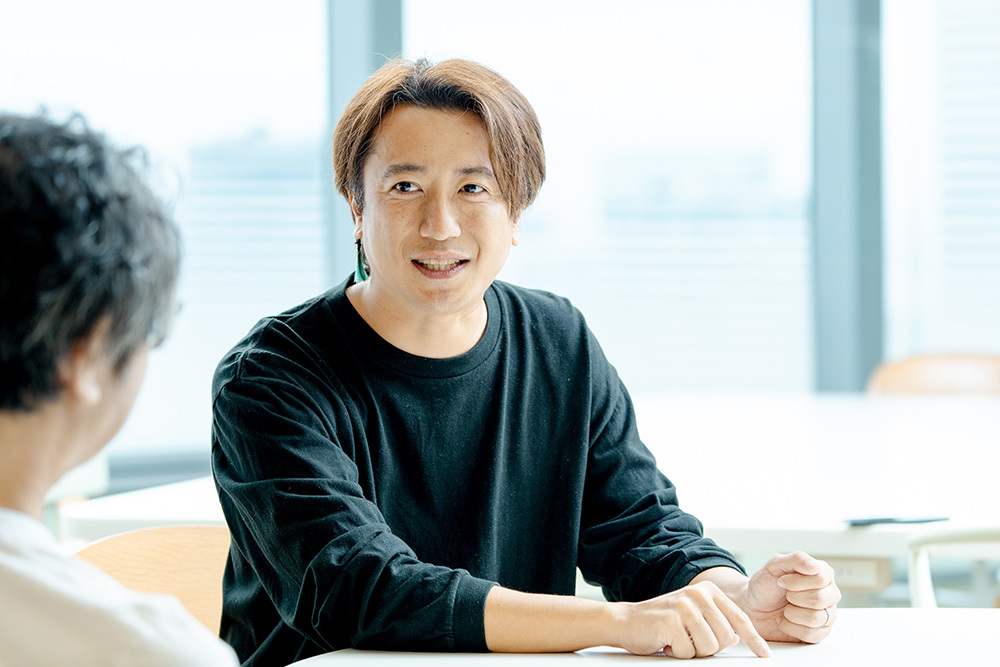
There are still many untapped approaches for audio advertising.
Namikawa: Let's explore the potential of Spotify and audio advertising in marketing a bit further. Even within audio advertising, what do you think distinguishes Spotify from radio?
Kawada: Radio is often listened to in groups or as background listening. In contrast, Spotify is frequently used for solo, immersive listening. Plus, users can access their desired content anytime, 24/7. These characteristics make it a platform where users engage very actively, which is a major difference compared to radio. Furthermore, from an ad delivery perspective, the ability to precisely target listeners is a significant strength.
Shima: Precisely because users are actively and immersively listening alone, effectively placing ads there seems like it could be highly impactful.
Namikawa: How does it differ from TV commercials or video ads?
Shima: It varies depending on the approach, but with audio ads, once you have that one core idea – like "this sound will resonate" – it tends to become the central concept driving the entire creation process. Take the "Wakatsu Burger" ad, for example: "Wakatsu and Takasu sound similar, so this will work." It's about building everything around that core sound concept.
Kawada: True, with TV commercials or video ads, relying solely on an audio concept feels like it lacks a backbone. You'd likely feel you need another core idea. You also have to think about how to visualize it, how to shoot it, and who the cast should be.
Shima: Another characteristic of audio ads is that in a world of just sound, you can really expand the listener's imagination. The moment the listener imagines a visual scene in their head based on the audio alone, you've won. Like radio, the strength of audio media lies in creating a one-on-one relationship between sender and listener. There's an intimacy, almost like talking to a friend, and a definite sense that the media is "speaking" directly to the listener. Furthermore, since Spotify is often listened to with headphones for immersion, it can create an even stronger "one-on-one" feeling than radio, depending on how it's done. If we focus on that, couldn't we create ads that build an even deeper complicity with listeners?
Namikawa: Mr. Kawada, are there any types of ads you'd like to try in the future?
Kawada: This time, we had ads using parody songs for Takasu Clinic and Yoshio Kojima's signature routines, but I'm also thinking about reviving famous CM songs from the past.
Namikawa: I see. Music is deeply tied to memories for each generation. Stimulating the memories of a specific generation might boost advertising effectiveness.
Shima: Absolutely. "Sound memories" can instantly bring back vivid sensations from the past, right?
Namikawa: When we talk about "brand assets," we often think of visual elements like logos, but this really makes me realize that "sound" – like CM songs or jingles – is also a key part of that.
Kawada: Another major feature of Spotify is its broad "derivative domains" while still being audio-based. Listeners often browse the app while listening, so it feels wasteful to see it only as an audio medium. Of course, you can create "tricks unique to audio," and Spotify ads often focus on that. But you could also combine audio ads with video. For example, an ad that works perfectly well as audio alone, but when you actually see the video, it creates a completely different impression.
Namikawa: Thinking about it this way, it seems there are still many untapped approaches for Spotify and audio advertising. When I consider what a brand is, I think it's about "differentiation from other companies." By challenging new media like Spotify, I believe we can express this "differentiation" in various forms. Hearing your discussions today made me feel that by thinking about this, we can create new experiences that leave a lasting impression of the brand on listeners. Thank you both for today.









